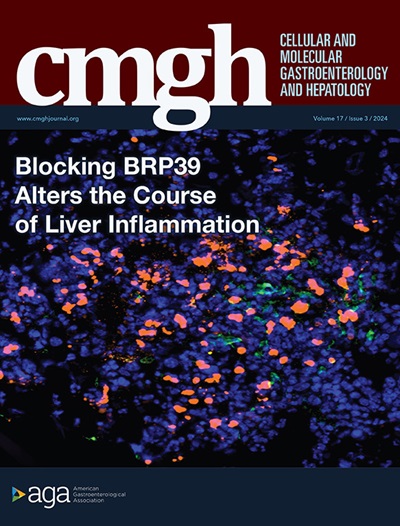Attenuating ABHD17 Isoforms Augments the S-acylation and Function of NOD2 and a Subset of Crohn’s Disease-associated NOD2 Variants
IF 7.1
1区 医学
Q1 GASTROENTEROLOGY & HEPATOLOGY
Cellular and Molecular Gastroenterology and Hepatology
Pub Date : 2025-01-01
DOI:10.1016/j.jcmgh.2025.101491
引用次数: 0
Abstract
Background & Aims
NOD2 is an intracellular innate immune receptor that detects bacterial peptidoglycan fragments. Although nominally soluble, some NOD2 is associated with the plasma membrane and endosomal compartments for microbial surveillance. This membrane targeting is achieved through post-translational S-acylation of NOD2 by the protein acyltransferase ZDHHC5. Membrane attachment is necessary to initiate a signaling cascade in response to cytosolic peptidoglycan fragments. Ultimately, this signaling results in the production of antimicrobial peptides and proinflammatory cytokines. In most cases, S-acylation is a reversible post-translational modification with removal of the fatty acyl chain catalyzed by one of several acyl protein thioesterases. Deacylation of NOD2 by such an enzyme will displace it from the plasma membrane and endosomes, thus preventing signaling.
Methods
To identify the enzymes responsible for NOD2 deacylation, we used engineered cell lines with RNA interference and small-molecule inhibitors. These approaches were combined with confocal microscopy, acyl-resin-assisted capture, immunoblotting, and cytokine multiplex assays.
Results
We identified α/β-hydrolase domain-containing protein 17 isoforms (ABHD17A, ABHD17B, and ABHD17C) as the acyl protein thioesterases responsible for NOD2 deacylation. Inhibiting ABHD17 increased the plasma membrane localization of wild-type NOD2 and a subset of poorly acylated Crohn’s disease-associated variants. This enhanced NOD2 activity, increasing NF-κB activation and pro-inflammatory cytokine production in epithelial cells.
Conclusions
These findings demonstrate that ABHD17 isoforms are negative regulators of NOD2. The results also suggest that targeting ABHD17 isoforms could restore functionality to specific Crohn’s disease-associated NOD2 variants, offering a potential therapeutic strategy.

减弱ABHD17亚型可增强NOD2和克罗恩病相关NOD2亚型的s酰化和功能。
背景和目的:NOD2是一种检测细菌肽聚糖片段的细胞内先天免疫受体。虽然名义上是可溶的,但一些NOD2与质膜和内体区室有关,用于微生物监测。这种膜靶向是通过蛋白酰基转移酶ZDHHC5对NOD2的翻译后s酰化来实现的。膜附着是启动响应胞质肽聚糖片段的信号级联所必需的。最终,这种信号传导导致抗菌肽和促炎细胞因子的产生。在大多数情况下,s -酰化是一种可逆的翻译后修饰,由几种酰基蛋白硫酯酶之一催化去除脂肪酰基链。这种酶对NOD2的去酰化将使其从质膜和核内体中移位,从而阻止信号传导。方法:利用RNA干扰和小分子抑制剂的工程细胞系,鉴定NOD2去酰化的酶。这些方法与共聚焦显微镜、酰基树脂辅助捕获、免疫印迹和细胞因子多重检测相结合。结果:我们发现含有α/β-水解酶结构域的蛋白17亚型(ABHD17A、ABHD17B和ABHD17C)是负责NOD2去酰化的酰基蛋白硫酯酶。抑制ABHD17增加了野生型NOD2和低酰化克罗恩病相关变异体的质膜定位。这增强了NOD2活性,增加了上皮细胞中NF-κB的激活和促炎细胞因子的产生。结论:这些发现表明ABHD17亚型是NOD2的负调控因子。结果还表明,靶向ABHD17亚型可以恢复特定克罗恩病相关NOD2变异的功能,提供了一种潜在的治疗策略。
本文章由计算机程序翻译,如有差异,请以英文原文为准。
求助全文
约1分钟内获得全文
求助全文
来源期刊

Cellular and Molecular Gastroenterology and Hepatology
Medicine-Gastroenterology
CiteScore
13.00
自引率
2.80%
发文量
246
审稿时长
42 days
期刊介绍:
"Cell and Molecular Gastroenterology and Hepatology (CMGH)" is a journal dedicated to advancing the understanding of digestive biology through impactful research that spans the spectrum of normal gastrointestinal, hepatic, and pancreatic functions, as well as their pathologies. The journal's mission is to publish high-quality, hypothesis-driven studies that offer mechanistic novelty and are methodologically robust, covering a wide range of themes in gastroenterology, hepatology, and pancreatology.
CMGH reports on the latest scientific advances in cell biology, immunology, physiology, microbiology, genetics, and neurobiology related to gastrointestinal, hepatobiliary, and pancreatic health and disease. The research published in CMGH is designed to address significant questions in the field, utilizing a variety of experimental approaches, including in vitro models, patient-derived tissues or cells, and animal models. This multifaceted approach enables the journal to contribute to both fundamental discoveries and their translation into clinical applications, ultimately aiming to improve patient care and treatment outcomes in digestive health.
 求助内容:
求助内容: 应助结果提醒方式:
应助结果提醒方式:


